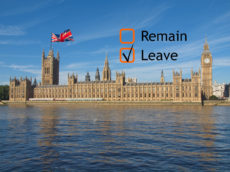Randall G. Holcombe • Monday, June 27, 2016 •
 Brexit
Brexit
In the short time since the Brits voted to exit the EU, much of the commentary I’ve read views the vote as a move toward isolationism. Regardless of the motivations of the voters, a more accurate way to look at it is that the British voted for self-government rather than government from afar.
The EU originated in the idea of a common market in which goods and people could cross borders unimpeded, giving Europe some of the advantages the United States has had in that regard. That is a good idea. One impediment is the complaint by businesses that the governments of other countries give advantages to their businesses–regulatory advantages, tax advantages, subsidies–that create unfair competition. So, along with open borders came agreements for uniform tax systems and regulations to level the playing field. With its foot in the door, the EU government continued to expand its powers over the member countries. It is easy to argue that while Britain benefits from the open borders, the cost imposed on it by the EU regulatory state ultimately makes Britain a net loser.
The long term consequences of Brexit depend on how the EU responds to Britain’s withdrawal. They can work out trade agreements to leave arrangements between Britain and the EU essentially unchanged, to everyone’s benefit. Or, they can erect trade barriers and place demands on Britain that reduce welfare for both the Brits and the remainder of the EU. Any negative consequences on the British economy will be due to a reduction in gains from trade, so any harm to the British economy will be mirrored by a similar harm to the remainder of the EU.
Kevin Dowd • Sunday, June 26, 2016 •

[See Part 2 Here]
Thursday, 23 June 2016, will go down in history as the United Kingdom’s own Independence Day. American readers will hopefully appreciate the irony.
The take-home message is that people in the UK lost confidence in a complacent and corrupt European Union (EU) elite that wouldn’t listen to them and was dragging them against their will towards ever closer integration.
There is a deeper message too. Virtually the entire establishment, inside and outside the UK, were telling the UK electorate that they had no choice but to vote “Remain.” Inside the UK, the government, the major political parties, the majority of MPs, the Treasury, the Bank of England, the big economic research institutions, almost the entire UK economics profession, and most Big Business CEOs were all telling them to Remain. Outside the UK, almost every world leader from Barack Obama on down, every central bank governor, every major international institution, Goldman Sachs and Paul Krugman were repeating the same message. They did everything possible to scare the voters: the world would end if they had the effrontery to vote “Leave.”
Robert Higgs • Sunday, June 26, 2016 •
 Constant surveillance
Constant surveillance
State’s prying eyes seek your wrongs
Yours alone, not state’s
******
Got nothing to hide?
Not to worry, citizen
State makes no mistakes
******
But if it should err
You will pay the error’s price
State will not confess
John R. Graham • Saturday, June 25, 2016 •
 New research from the Healthcare Bluebook (sponsored by the Ambulatory Surgery Center Association) indicates the privately insured population saved $38 billion by using Ambulatory Surgery Centers (ASCs) instead of hospital outpatient departments for day surgeries. That figure includes $5 billion of lower out-of-pocket costs paid by patients directly.
New research from the Healthcare Bluebook (sponsored by the Ambulatory Surgery Center Association) indicates the privately insured population saved $38 billion by using Ambulatory Surgery Centers (ASCs) instead of hospital outpatient departments for day surgeries. That figure includes $5 billion of lower out-of-pocket costs paid by patients directly.
What is remarkable is that only 48 percent of procedures (such as joint replacement) that can currently be done in either setting are actually done in ASCs. Assuming it would not be appropriate for three percent of surgeries to be done at ASCs (due to complexity), the study estimates that shifting the balance of procedures to ASCs would save yet another $38 billion. Plus, shifting other procedures, not currently done at ASCs, would save another $56 billion.
Why are private insurers and employers leaving this money on the table? The study notes that hospitals are concentrated and have stronger bargaining power over payers than do ASCs. So, why do not more ASCs open up? Because ASCs are often owned by physicians, laws discriminate against them versus non-profit hospitals. Although federal laws do not discriminate against ASCs as badly as they do physician-owned hospitals, laws in some states prevent new ASCs from entering markets to compete against hospitals. (See this New Jersey law, for example.)
Nevertheless, insurers and employers should be able to do a better job of getting rates down. The California Public Employees Retirement System (CalPERS) reduced costs of joint replacement, cataract surgery, and arthroscopy by $6.4 million in two years by implementing “reference pricing,” whereby high-quality settings with a wide range of fees were paid the same reference price (based on the low-cost providers’ fees). If patients wanted higher-cost facilities, they paid the difference out of pocket.
CalPERS’ reference pricing started in 2008. How can it not be the norm today? Evidence continues to build that health insurance, as it is currently designed in the United States, does not add value.
Vicki E. Murray-Alger • Friday, June 24, 2016 •
 One export I’d like from California is its pre-Common Core math standards, hailed as the country’s finest. Instead, we’re likely going to get some horrific version of its pending K-12 history and social “science” framework—or as the Hoover Institution’s Bill Evers calls it, Progressive “goo-goo reform.”
One export I’d like from California is its pre-Common Core math standards, hailed as the country’s finest. Instead, we’re likely going to get some horrific version of its pending K-12 history and social “science” framework—or as the Hoover Institution’s Bill Evers calls it, Progressive “goo-goo reform.”
Whether or not we live in California, we need to pay close attention to its State Board of Education, which meets on July 13 to consider adopting the new history and social sciences framework. Here’s why.
California has the highest public K-12 enrollment nationwide, with more than one out of 10 school children, nearly 6.3 million. So it’s fair to say that as California goes, so goes the country since textbook companies will be customizing their wares for their largest market before peddling them to other states.
Stanley Kurtz, Ethics and Public Policy Center Senior Fellow, warns in painful detail that if this happens, we should brace ourselves for a hard left turn, even by Left Coast standards.
John R. Graham • Friday, June 24, 2016 •
 An eminent physician has tentatively proposed that published treatment guidelines be accompanied by dissenting expert opinions, much like U.S. Supreme Court decisions.
An eminent physician has tentatively proposed that published treatment guidelines be accompanied by dissenting expert opinions, much like U.S. Supreme Court decisions.
Daniel Musher, MD, of Baylor College of Medicine, served on the Advisory Committee on Immunization Practice of the Centers for Disease Control and Prevention, which considered guidelines for a dual vaccine approach for pneumococcal vaccination for adults. He disagreed strongly with the published recommendation, but was prevented from publishing his opinion alongside the recommendation.
Dr. Musher believes the publishing of dissenting opinions is very valuable to the progress of knowledge:
As citizens of the United States, we are as much bound by a 5-4 decision of the High Court as a 9-0 vote (although closely passed decisions are more likely to be overturned in future cases).1 Similarly, as practitioners of medicine, until new guidelines are written, we are seriously constrained by, if not actually bound by, existing ones, without regard to the unanimity of opinion in the recommending committee. Nevertheless, there is much to gain from studying dissenting opinions, as was famously shown by the writings of Justices Holmes and Brandeis, many of whose minority opinions, in time, became the law of the land.2 I propose that the failure to publish differing or dissenting views in medical guidelines presents our profession with an inappropriately monolithic view—one that is studied as gospel by physicians-in-training and forced on practitioners by incorporation into a variety of performance measures.
Abigail R. Hall • Thursday, June 23, 2016 •
 I’ve written extensively on the benefits of ride-sharing companies like Uber and Lyft. I’ve discussed how these companies, using the technology in smart phones, allow customers to request a ride and track their vehicle and driver. The firms operate in hundreds of cities and in more than 20 countries.
I’ve written extensively on the benefits of ride-sharing companies like Uber and Lyft. I’ve discussed how these companies, using the technology in smart phones, allow customers to request a ride and track their vehicle and driver. The firms operate in hundreds of cities and in more than 20 countries.
These companies have received an immense amount of criticism. From their pricing system, to supposed “safety concerns,” a variety of individuals and groups have called for the regulation of these companies. Others have suggested they be banned outright. Most recently, the city of Austin, Texas expelled Uber from the city for failing to comply with regulation.
I’ve argued at length that it is politics, not safety, and certainly not consumer welfare, that is behind the Uber backlash. Decades ago, cab companies and governments found they could enter into a mutually beneficial exchange through regulation. Cab companies would be granted licenses in exchange for a fee. These licenses would work to artificially increase fare prices while simultaneously limiting competition. In order to “play the game” you’d have to a license. This barrier to entry effectively prevented taxi firms from having to compete for customers–they were the only game in town. Governments, meanwhile, saw benefits in the form of the fees paid by cab companies.
Vicki E. Murray-Alger • Thursday, June 23, 2016 •
 Now that school is out, there’s time to do some much-needed housekeeping, including a review of states’ shares of federal education funding.
Now that school is out, there’s time to do some much-needed housekeeping, including a review of states’ shares of federal education funding.
Education expert Richard Innes, an analyst at Kentucky’s Bluegrass Institute, used Census data to see which states get the highest shares. Turns out, a handful of taker states should be writing thank you notes to taxpayers in the vast majority of giver states, based on Innes’ analysis.
On average, federal dollars (which, of course, come from taxpayers in the states) account for less than 10 percent of all education funding, with state and local sources making up the vast majority.
Five states exceeded this federal funding average, approaching or exceeding 15 percent: Mississippi, Louisiana, South Dakota, New Mexico, and Arizona. The actual dollar amounts vary, but they range between $195 million for South Dakota to nearly $1.2 billion for Arizona.
As Innes explains, “Of course, this federal money is far from ‘free’.” That’s because states have to agree to a variety of mandates. “Some have been OK, others are terrible. But, all result in a dilution of state and local control of education without any really dramatic evidence that the feds know better than we do. Furthermore, this is being driven by a relatively small total contribution from the federal government in comparison to a rather massive amount of state and local education dollars,” according to Innes.
Randall G. Holcombe • Wednesday, June 22, 2016 •
 The United States was founded on an ideology that viewed the role of government as the protection of individual rights. That view of government was pushed aside by the ideology of Progressivism toward the end of the 1800s. The Progressive ideology envisions a government that not only protects individual rights but also looks out for people’s economic well-being.
The United States was founded on an ideology that viewed the role of government as the protection of individual rights. That view of government was pushed aside by the ideology of Progressivism toward the end of the 1800s. The Progressive ideology envisions a government that not only protects individual rights but also looks out for people’s economic well-being.
A natural tension exists between Progressivism and freedom. Partly, this is because looking out for the economic well-being of some often lowers the economic well-being of others. Increasingly, Progressives also argue that people would be better off if government made their choices for them rather than giving people the freedom to make their own choices.
One motivation for the Progressive ideology was the perception that people who held substantial economic power were using that power to exploit those with less power. Thus, the Interstate Commerce Commission was established in 1887 to regulate railroads to keep them from exploiting shippers, and the Sherman Antitrust Act was passed in 1890 to limit the ability of concentrated economic interests to exploit others.
John R. Graham • Tuesday, June 21, 2016 •
 David Lazarus of the Los Angeles Times, whose columns on health policy tilt heavily towards single-payer advocacy, has done a great service to the cause of consumer-driven health care: In a recent piece he describes how much more sense it makes to pay cash prices for health services than to pay what your health insurer “negotiates” supposedly on your behalf.
David Lazarus of the Los Angeles Times, whose columns on health policy tilt heavily towards single-payer advocacy, has done a great service to the cause of consumer-driven health care: In a recent piece he describes how much more sense it makes to pay cash prices for health services than to pay what your health insurer “negotiates” supposedly on your behalf.
Five blood tests were performed in March at Torrance Memorial Medical Center. The hospital charged the patient’s insurer, Blue Shield of California, $408. The patient was responsible for paying $269.42.
Tests that were billed to Blue Shield at a rate of about $80 each carried a cash price of closer to $15 apiece.
“This is one of the dirty little secrets of healthcare,” said Gerald Kominski, director of the UCLA Center for Health Policy Research. “If your insurance has a high deductible, you should always ask the cash price.”
Not all medical facilities will be open to sharing their cash prices with an insured person, Kominski said, but many will.
 Brexit
Brexit
 Constant surveillance
Constant surveillance New research
New research One export I’d like from California is its pre-Common Core math standards,
One export I’d like from California is its pre-Common Core math standards,  An eminent physician has tentatively proposed that published treatment guidelines be accompanied by dissenting expert opinions, much like U.S. Supreme Court decisions.
An eminent physician has tentatively proposed that published treatment guidelines be accompanied by dissenting expert opinions, much like U.S. Supreme Court decisions. I’ve written extensively on the benefits of ride-sharing companies like Uber and Lyft. I’ve discussed how these companies, using the technology in smart phones, allow customers to request a ride and track their vehicle and driver. The firms operate in hundreds of cities and in more than 20 countries.
I’ve written extensively on the benefits of ride-sharing companies like Uber and Lyft. I’ve discussed how these companies, using the technology in smart phones, allow customers to request a ride and track their vehicle and driver. The firms operate in hundreds of cities and in more than 20 countries. Now that school is out, there’s time to do some much-needed housekeeping, including a review of states’ shares of federal education funding.
Now that school is out, there’s time to do some much-needed housekeeping, including a review of states’ shares of federal education funding. The United States was founded on an ideology that viewed the role of government as the protection of individual rights. That view of government was pushed aside by the ideology of Progressivism toward the end of the 1800s. The Progressive ideology envisions a government that not only protects individual rights but also looks out for people’s economic well-being.
The United States was founded on an ideology that viewed the role of government as the protection of individual rights. That view of government was pushed aside by the ideology of Progressivism toward the end of the 1800s. The Progressive ideology envisions a government that not only protects individual rights but also looks out for people’s economic well-being. David Lazarus of the Los Angeles Times, whose columns on health policy tilt heavily towards single-payer advocacy, has done a great service to the cause of consumer-driven health care: In
David Lazarus of the Los Angeles Times, whose columns on health policy tilt heavily towards single-payer advocacy, has done a great service to the cause of consumer-driven health care: In 




